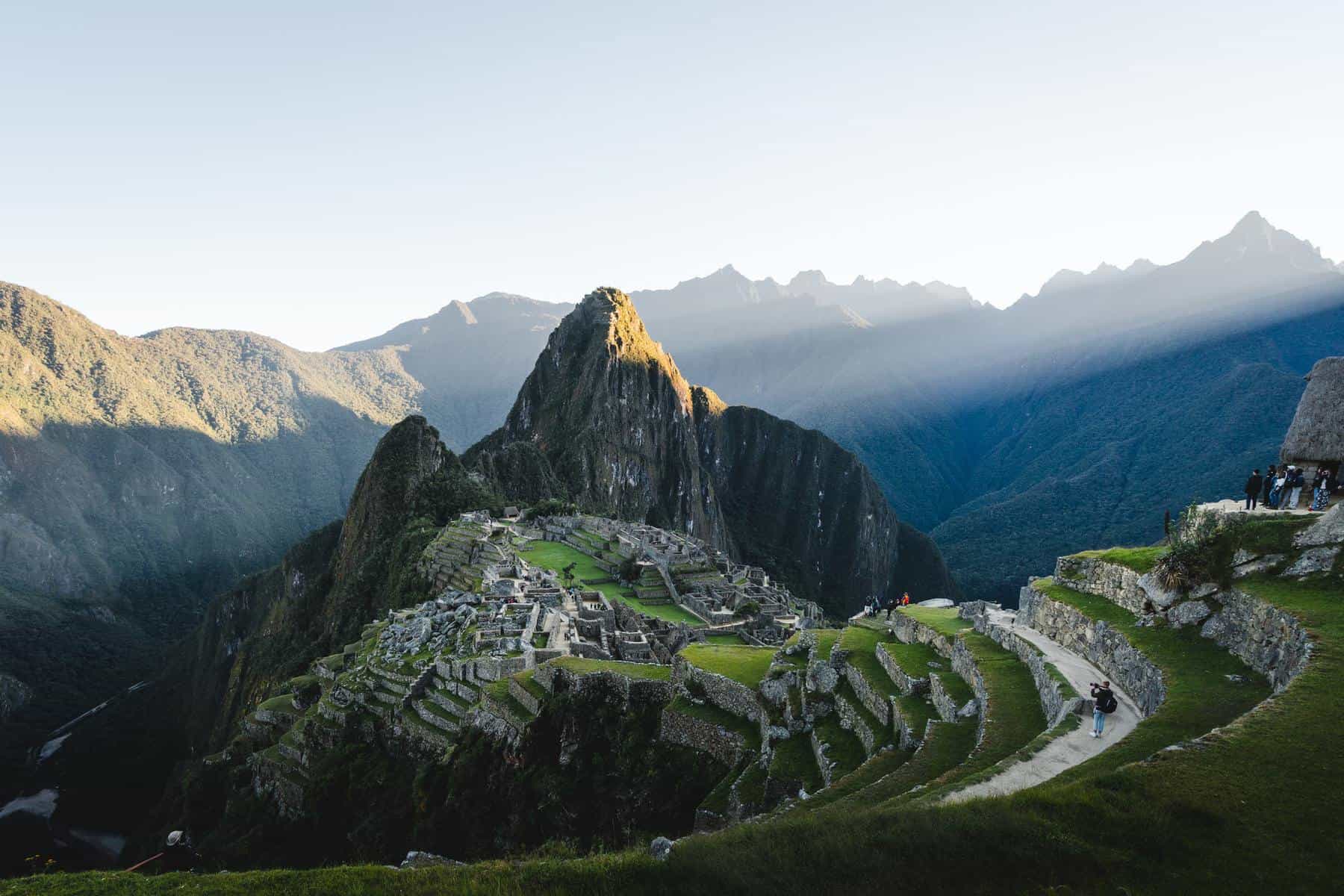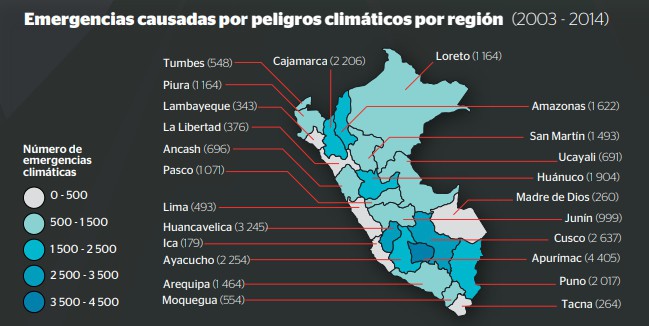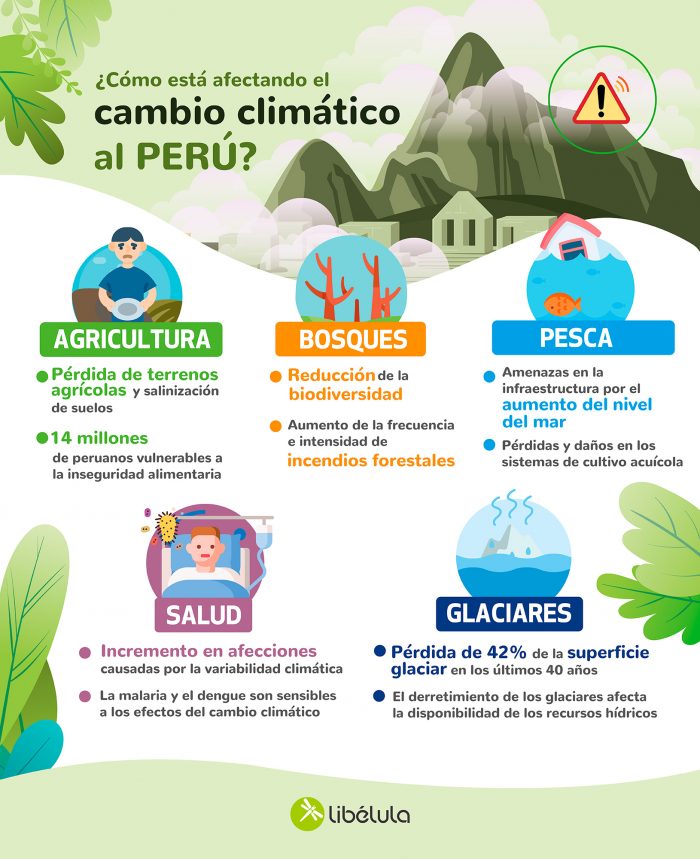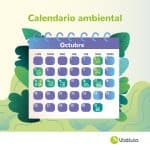How climate change is already affecting to Peru?

Peru is recognized as one of the 17 megadiverse countries, possessing more than 70% of the planet's biodiversity. The country's biodiversity is represented by a great variety of ecosystems, flora and fauna species, and genetic diversity, which contribute to global development and sustainability.[1]. According to WHO, a loss in biodiversity can have significant effects on health services because, indirectly, health depends on ecosystem products and services (such as fresh water, food and energy sources).[2].
How vulnerable are we?

Studies on "Recent trends in the current climate and its extremes" reveal that the temperature and precipitation regime is changing throughout the national territory.
Peru is also exposed to the El Niño Phenomenon (ENF), which is occurring with greater frequency and intensity.[7]. Although the ENF is considered climate variability, there are studies that reveal that climate change favors extreme events such as El Niño in both frequency and intensity.[8]. Economic losses in Peru due to El Niño 2015-2016 reached approximately USD 3.7 billion.[9].
How is it affecting us?
The most vulnerable sectors and ecosystems include agriculture, forests, fisheries and aquaculture, health and glaciers, whose main impacts are shown below:
Agriculture
- Decrease in potato production in the coast and highlands, due to high temperatures and excess humidity.[10].
- Loss of agricultural land and salinization of soils[11].
- Clogging of reservoirs[12].
- Destruction of productive infrastructure[13].
- Low meat and milk production due to high temperatures[14].
- Climate change implies a risk for farmers and farm workers, as well as for the country's own food security. This situation is aggravated if we consider that 55% of the population living in poverty works in activities that sustain the country's primary food production systems.[15].
- 14 million Peruvians vulnerable to food insecurity[16].
Forests
- Changes and alteration of the functionality of ecosystem services provided by forests.[17].
- Effects on forest pests and the damage they cause directly, influencing their development, survival, reproduction and dispersal and altering host defenses and susceptibility, and indirectly ecological relationships, such as changing the abundance of competitors, parasites and predators.[18].
- Increased frequency and intensity of forest fires due to warmer and drier conditions, along with other phenomena related to global change.[19].
- By 2030, 15% of the country's Natural Protected Areas (NPAs), under the current conditions of exposure and adaptive capacity, will have a high vulnerability to climate change and 62% of the NPAs will have a medium vulnerability.[20].
- Reduction of biodiversity in the Amazon, modification in the distribution of biological communities; desertification and soil erosion; the occurrence of droughts and atypical rainfall and the scarcity of forest resources that provide food for peasant communities and indigenous populations.[21].
Fishing and agriculture
- Direct consequences on the productivity and spatial distribution of fishery resources due to the increase in sea temperature and variations in the concentration of CO2.
- Sea level rise causes coastal erosion and threatens existing infrastructure, affecting fisheries and tourism[22].
- The upwelling system, favorable to the development of high fish productivity, is affected by climate change.[23].
- Losses and damage to aquaculture farming systems due to climatic conditions such as El Niño events or strong temperature increases in the sea. [24].
- All aquaculture species are poikilotherms, where a variation in temperature could have a significant influence on overall metabolism and thus on growth rates and total production.[25].
Health
Glaciers and water resources
- Loss of 42% of glacier surface in the last 40 years. This implies a reduction in ice volume of between 32 and 35 km.3mainly the smallest glaciers are affected.[28].
- The melting of glaciers implies an increase in the number of glacial lakes. At present, a total of 8,355 lagoons have been recorded, which constitute an invaluable water reserve, but at the same time pose a risk to the populations located in the lower parts of the basins.[29].
- The melting of glaciers has consequences on the availability of water resources or water reserves, which is aggravated by problems in the quality of their sources and inadequate management and management of water resources, thus increasing the vulnerability of users.[30].
- In the early stages of glacial retreat, flow tends to increase due to an acceleration of glacial melt but, after reaching a peak in flow as the water reservoir has gradually emptied, runoff tends to decrease. This has been evidenced in the Cordillera Blanca of Peru where seven of nine river basins have probably crossed the critical threshold and now have lower dry season discharge.[31].
What are we doing about it?
In this regard, the Peruvian government has made great progress in the comprehensive management of climate change:
- In institutional terms:
- The adoption of the Paris Agreement, ratified by Peru in July 2016, which has as its central objective to prevent the increase in the planet's average global temperature from exceeding 2°C above pre-industrial levels and to promote additional efforts to ensure that global warming does not exceed 1.5°C, as well as to increase the ability to adapt to the effects of climate change and foster resilience to climate variability.[32].
- Approval of the Framework Law on Climate Change[33] and its Regulations[34]The project will promote that each public entity at the national level report on adaptation and mitigation actions and will promote that management, development planning and sectoral investment instruments include such actions.
- Approval of the Gender and Climate Change Plan of Action[35]Peru is the first country in South America to have this management instrument, which will strengthen the development of the capacities of the populations most vulnerable to the adverse effects of climate change, allowing equal opportunities and rights for their sustainable development.
- Preparation of the National Adaptation Plan (NAP), which will be a strategic document that will guide adaptation to climate change in Peru, supported by two major frameworks, the Paris Agreement and the Framework Law on Climate Change.
- In terms of action:
- The creation of the temporary Multisectoral Working Group generated technical information to guide the implementation of the Nationally Determined Contributions (GTF-NDC). After 22 months of multisectoral work, 91 adaptation measures and 62 mitigation measures were approved as part of Peru's Nationally Determined Contributions (NDC) to the year 2030, whose goal is to achieve a reduction in GHG emissions of 20% in 2030, with respect to the base year 2010 and considering a scenario Business as usual (BaU) emissions increase. The target could be increased by 10% conditional on support from international cooperation.[36].
- The implementation of the INFOCARBONO web platform[37] which allows us to comply with international agreements on climate change as well as to monitor compliance with the goals established in the NDCs.
- Land Degradation Neutrality Target (LDN) definition[38] 2030 and identification of NDC adaptation and mitigation measures on agriculture and forests that contribute to achieving neutrality in land degradation, maintaining healthy ecosystems, strengthening food security and, consequently, the well-being of the population.
- The Agreement with the United Kingdom of Great Britain and Northern Ireland for technical assistance in the execution of major prevention and reconstruction works in the areas of the country that were affected by the El Niño Coastal Phenomenon. This agreement will mean, in the next two years, an investment of approximately S/. 7,000 million to be executed in nine regions of the country: Tumbes, Piura, Lambayeque, Cajamarca, La Libertad, Ancash, Lima, Ica and Huancavelica.[39].
- Publication of general guidelines for the application of climate information on historical trends, extreme events and projections of national climate scenarios, as provided for in the Regulations of Framework Law No. 30754 on Climate Change.[40].
In conclusion
In relation to the above, it can be stated that climate change is a concrete reality and that its impacts are already being felt in the country and will be increasingly severe. For this reason, the Ministry of the Environment, in its capacity as the National Authority on climate change, has been carrying out various actions to mitigate the effects of climate change. However, this effort requires the participation of various actors, such as the private sector, academia, civil society, indigenous peoples, and ordinary citizens, among others, in order to drive the country's climate action towards sustainable development that is low in emissions and resilient to climate change.

[1] MINAM, 2014. The National Biodiversity Strategy to 2021 and its Action Plan 2014-2018. Lima, Peru. Available at: https://sinia.minam.gob.pe/documentos/estrategia-nacional-diversidad-biologica-2021-plan-accion-2014-2018
[2] WHO, 2020. Climate change and human health. Available in: https://www.who.int/globalchange/ecosystems/biodiversity/en/
[3] Low-lying coastal areas, arid and semi-arid areas, areas exposed to floods, droughts and desertification, fragile mountain ecosystems, disaster-prone areas, areas with high urban air pollution, and economies highly dependent on income generated by the production and use of fossil fuels.
[4] MINAM, 2016. Third National Communication of Peru to the United Nations Framework Convention on Climate Change. Lima, Peru. Available at: http://www.minam.gob.pe/wp-content/uploads/2016/05/Tercera-Comunicaci%C3%B3n.pdf
[5] Ibid.
[6] Climate Change Management Support Project, 2020. Report of the Webinar "Climate Change Scenarios in Peru to 2050. Strategic Information for Decision Making". Lima, Peru. Available at: Link to project web page.
[7] MINAM, 2016. Forest and Climate Change Strategy. Lima, Peru. Available at: http://www.bosques.gob.pe/archivo/ff3f54_ESTRATEGIACAMBIOCLIMATICO2016_ok.pdf
[8] Wang, B., Luo, X., Yang, Y.-M., Sun, W., Cane, M.A., Cai, W., Yeh S.-W., & Liu, J. (2019). Historical change of El Niño properties sheds light on future changes of extreme El Niño. Proc. Natl. Acad. Sci., doi: 10.1073/pnas.1911130116. Available at: http://iprc.soest.hawaii.edu/news/press_releases/2019/19_10_21_Wang_ElNinoChanges.pdf
[9] Martinez, Rodney & Zambrano, Eduardo & Nieto, Juan & Hernández Cotrina, Julian & Costa, Felipe & Fiallo, Elba & Ycaza, Pilar & Zambrano, Roxanna, 2017. El Niño 2015-16: Evolution, Vulnerability and Impacts in Latin America. Available at: https://www.researchgate.net/publication/321724092_El_Nino_2015-16_evolucion_vulnerabilidad_e_impactos_en_Latinoamerica
[10] MINAM, 2016. Third National Communication of Peru to the United Nations Framework Convention on Climate Change. Lima, Peru. Available at: http://www.minam.gob.pe/wp-content/uploads/2016/05/Tercera-Comunicaci%C3%B3n.pdf
[11] Ibid.
[12] Ibid.
[13] Ibid.
[14] Ibid.
[15] MINAM, 2018. Final Report of the Multisectoral Working Group of a temporary nature in charge of generating technical information to guide the implementation of the Nationally Determined Contributions (GTM-NDC). Available at: http://www.minam.gob.pe/cambioclimatico/wp-content/uploads/sites/127/2018/12/Informe-final-GTM-NDC_v17dic18.pdf
[16] MINAM, 2018. Nationally Determined Contributions. Lima, Peru. Available at: http://www.minam.gob.pe/cambioclimatico/wp-content/uploads/sites/127/2018/06/Dossier-NDC.pdf
[17] SERFOR, 2018. Tentative Programming for adaptation measures in the thematic area of forests. National Forestry and Wildlife Service. Lima, Peru.
[18] Ibid.
[19] Ibid.
[20] SERNANP, 2014. Análisis de Vulnerabilidad de las Áreas Naturales Protegidas frente al Cambio Climático al 2030, 2050 y 2080. Available at: https://www.researchgate.net/publication/275642495_Analisis_de_vulnerabilidad_de_las_areas_naturales_protegidas_frente_al_cambio_climatico
[21] MINAM, 2016. National Strategy on Forests and Climate Change. Available at: http://www.bosques.gob.pe/archivo/ff3f54_ESTRATEGIACAMBIOCLIMATICO2016_ok.pdf
[22] MINAM, 2016. Third National Communication of Peru to the United Nations Framework Convention on Climate Change. Lima, Peru. Available at: http://www.minam.gob.pe/wp-content/uploads/2016/05/Tercera-Comunicaci%C3%B3n.pdf
[23] IDB, 2019. Peru's progress in adapting to climate change in the fisheries sector and the marine-coastal ecosystem. Lima, Peru. Available at: https://publications.iadb.org/es/avances-del-peru-en-la-adaptacion-al-cambio-climatico-del-sector-pesquero-y-del-ecosistema-marino
[24] PRODUCE, 2018. Tentative Sectorial Programming of the Thematic Area of Fisheries and Aquaculture. Ministry of Production. Lima, Peru Ibid.
[25] Ibid.
[26] MINAM, 2016. Third National Communication of Peru to the United Nations Framework Convention on Climate Change. Lima, Peru. Available at: http://www.minam.gob.pe/wp-content/uploads/2016/05/Tercera-Comunicaci%C3%B3n.pdf
[27] Ibid.
[28] MINAM, 2016. Third National Communication of Peru to the United Nations Framework Convention on Climate Change. Lima, Peru. Available at: http://www.minam.gob.pe/wp-content/uploads/2016/05/Tercera-Comunicaci%C3%B3n.pdf
[29] Ibid.
[30] MINAM, 2018. Final Report of the Multisectoral Working Group of a temporary nature in charge of generating technical information to guide the implementation of the Nationally Determined Contributions (GTM-NDC). Available at: http://www.minam.gob.pe/cambioclimatico/wp-content/uploads/sites/127/2018/12/Informe-final-GTM-NDC_v17dic18.pdf
[31] Libélula, 2014. Manual del Negociador de Cambio Climático Iberoamericano Hacia la consolidación del régimen climático internacional. Lima, Peru. Available at: https://libelula.com.pe/wp-content/uploads/2015/01/manual-del-negociador-de-cambio-climatico-final.pdf
[32] MINAM, 2016. The Paris Agreement: The long process towards success. Role, challenges and opportunities for Peru. Available at: http://www.minam.gob.pe/wp-content/uploads/2016/03/COP21-Final.pdf
[33] Available in: https://sinia.minam.gob.pe/documentos/ley-marco-cambio-climatico
[34] Available in: https://sinia.minam.gob.pe/normas/decreto-supremo-que-aprueba-reglamento-ley-no-30754-ley-marco-cambio
[35] MINAM, 2016. Gender and Climate Change Action Plan. Lima, Peru. Available at: https://www.gob.pe/institucion/minam/informes-publicaciones/306199-plan-de-accion-en-genero-y-cambio-climatico
[36] MINAM, 2018. Final Report of the Multisectoral Working Group of a temporary nature in charge of generating technical information to guide the implementation of the Nationally Determined Contributions (GTM-NDC). Available at: http://www.minam.gob.pe/cambioclimatico/wp-content/uploads/sites/127/2018/12/Informe-final-GTM-NDC_v17dic18.pdf
[37] Available in: http://infocarbono.minam.gob.pe/
[38] MINAM, 2020. Towards a Balanced Land and a Sustainable Peru: Conceptual Framework for Land Degradation Neutrality. Lima, Peru. Available at: https://www.gob.pe/institucion/minam/informes-publicaciones/702051-hacia-una-tierra-equilibrada-y-un-peru-sostenible
[39] https://www.rcc.gob.pe/2020/reino-unido-firmara-convenio-con-el-peru-para-dar-asistencia-tecnica-en-grandes-obras-de-reconstruccion/
[40] SENAMHI, 2020. General Guidelines that guide the application of climate information on historical trends, extreme events and projections of national climate scenarios. Lima, Peru. Available at: https://www.senamhi.gob.pe/load/file/00701SENA-1278.pdf
← Previous
Next →
News you may also like
Leer más
Leer más
Leer más
Stay up to date
Receive a summary of the most relevant news about companies and sustainability. Every month, free of charge!



